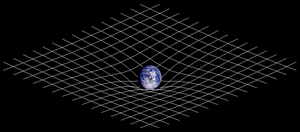B模:修订间差异
外观
删除的内容 添加的内容
Stuntaling(留言 | 贡献) 无编辑摘要 标签:添加文件 image 圖像檢查 |
补救1个来源,并将0个来源标记为失效。) #IABot (v2.0.9 |
||
| (未显示6个用户的9个中间版本) | |||
| 第2行: | 第2行: | ||
|1=zh-hans:引力波; zh-hant:重力波; |
|1=zh-hans:引力波; zh-hant:重力波; |
||
}} |
}} |
||
[[ |
[[Image:Gravitational lens-full.jpg|thumb|right|藝術繪圖顯示出,早期宇宙時期的光束,在傳播通過宇宙空間之時,怎樣被大質量宇宙構造所產生的引力透鏡效應所偏轉,形成B模。(Credit: ESA)]] |
||
'''B模偏振'''(B-mode polarization)是[[宇宙微波背景輻射]]的一種[[偏振]]信號。宇宙微波背景輻射的偏振圖樣可以分為兩個部分。一個是[[旋度]]為零的部分(類[[電場]]部分),稱為「E模偏振」,簡稱為「E模」,不具[[手徵性]]。2002年,[[度角尺度干涉儀]](DASI)最先發現這種偏振。另一個是[[散度]]為零、旋度不為零的部分(類[[磁場]]部分),稱為「B模偏振」,簡稱為「B模」,具有手徵性。<ref>[http://cosmology.berkeley.edu/~yuki/CMBpol/CMBpol.htm Cosmic Microwave Background Polarization: The Next Key Toward the Origin of the Universe], 2003, Yuki D. Takahashi</ref> |
'''B模偏振'''(B-mode polarization)是[[宇宙微波背景輻射]]的一種[[偏振]]信號。 宇宙微波背景輻射的偏振圖樣可以分為兩個部分。一個是[[旋度]]為零的部分(類[[電場]]部分),稱為「E模偏振」,簡稱為「E模」,不具[[手徵性]]。2002年,[[度角尺度干涉儀]](DASI)最先發現這種偏振。另一個是[[散度]]為零、旋度不為零的部分(類[[磁場]]部分),稱為「B模偏振」,簡稱為「B模」,具有手徵性。<ref>[http://cosmology.berkeley.edu/~yuki/CMBpol/CMBpol.htm Cosmic Microwave Background Polarization: The Next Key Toward the Origin of the Universe] {{Wayback|url=http://cosmology.berkeley.edu/~yuki/CMBpol/CMBpol.htm |date=20140215090233 }}, 2003, Yuki D. Takahashi</ref> |
||
[[宇宙學家]]預測存在兩種B模。第一種是在[[大爆炸]]短暫片刻後的[[宇宙暴脹]]過程中生成<ref>{{cite journal |
[[宇宙學家]]預測存在兩種B模。第一種是在[[大爆炸]]短暫片刻後的[[宇宙暴脹]]過程中生成<ref>{{cite journal |
||
| 第29行: | 第29行: | ||
==研究成果== |
==研究成果== |
||
2014年3月,[[BICEP2]]科學家團隊宣佈探測到第一種B模,符合早期宇宙暴脹期間所產生的[[引力波]],純量-張量比為 <math>r=0.2^{+0.07}_{-0.05}</math> <ref name="bmodes">{{cite news | url=http://www.theguardian.com/science/2014/mar/14/gravitational-waves-big-bang-universe-bicep | title=Gravitational waves: have US scientists heard echoes of the big bang? | 3= | publisher=[[The Guardian]] | date=2014-03-14 | accessdate=2014-03-14 | archive-date=2018-01-18 | archive-url=https://web.archive.org/web/20180118154832/https://www.theguardian.com/science/2014/mar/14/gravitational-waves-big-bang-universe-bicep | dead-url=no }}</ref><ref>{{Cite web |url=http://www.nytimes.com/2014/03/18/science/space/detection-of-waves-in-space-buttresses-landmark-theory-of-big-bang.html |title=存档副本 |accessdate=2014-03-19 |archive-date=2018-02-19 |archive-url=https://web.archive.org/web/20180219222002/https://www.nytimes.com/2014/03/18/science/space/detection-of-waves-in-space-buttresses-landmark-theory-of-big-bang.html?_r=0 |dead-url=no }}</ref>。2015年1月30日,研究團隊承認對於資料的判讀錯誤,觀測到的信號無法排除掉銀河系輻射塵埃的影響,不足以證實這項結果就是早期宇宙的引力波所形成的B模偏振<ref>{{cite web |
|||
2014年3月,[[BICEP2]]科學家團隊宣佈探測到第一種B模,符合早期宇宙暴脹期間所產生的[[引力波]],純量-張量比為<math>r=0.2^{+0.07}_{-0.05}</math> <ref name="bmodes">{{cite news |
|||
| ⚫ | |||
| url=http://www.theguardian.com/science/2014/mar/14/gravitational-waves-big-bang-universe-bicep |
|||
| first =Adrian |
|||
| title=Gravitational waves: have US scientists heard echoes of the big bang? | |
|||
| publisher=[[The Guardian]] | date=2014-03-14 | accessdate=2014-03-14 |
|||
}}</ref><ref>http://www.nytimes.com/2014/03/18/science/space/detection-of-waves-in-space-buttresses-landmark-theory-of-big-bang.html?_r=0</ref>。2015年1月30日,研究團隊承認對於資料的判讀錯誤,觀測到的信號無法排除掉銀河系輻射塵埃的影響,不足以證實這項結果就是早期宇宙的引力波所形成的B模偏振<ref>{{cite web |
|||
| ⚫ | |||
| title =Curtain falls on controversial big bang result |
| title =Curtain falls on controversial big bang result |
||
| work =Science |
| work =Science |
||
| date =2015-01-30 |
|||
| url =http://news.sciencemag.org/physics/2015/01/curtain-falls-controversial-big-bang-result |
| url =http://news.sciencemag.org/physics/2015/01/curtain-falls-controversial-big-bang-result |
||
| accessdate =2015-03-05 |
|||
| archive-date =2015-03-12 |
|||
| archive-url =https://web.archive.org/web/20150312220353/http://news.sciencemag.org/physics/2015/01/curtain-falls-controversial-big-bang-result |
|||
| dead-url =no |
|||
}}</ref>。 |
}}</ref>。 |
||
此前,[[南極望遠鏡]]已發現了第二種B模。這發現可能有助於檢驗有關宇宙起源的理論。科學家現在正在使用[[普朗克衛星]]所測得的數據做分析,希望能夠更進一步了解這些引力波。<ref>{{cite web |
此前,[[南極望遠鏡]]已發現了第二種B模。這發現可能有助於檢驗有關宇宙起源的理論。科學家現在正在使用[[普朗克衛星]]所測得的數據做分析,希望能夠更進一步了解這些引力波。<ref>{{cite web |
||
|last=ESA Planck|title=Planck Space Mission |
|last=ESA Planck |
||
|title=Planck Space Mission |
|||
|url=http://www.esa.int/Our_Activities/Space_Science/Planck |
|url=http://www.esa.int/Our_Activities/Space_Science/Planck |
||
|date=Oct 22, 2013|accessdate=Oct 23, 2013 |
|date=Oct 22, 2013 |
||
|accessdate=Oct 23, 2013 |
|||
|archive-date=2017-12-08 |
|||
|archive-url=https://web.archive.org/web/20171208015949/http://www.esa.int/Our_Activities/Space_Science/Planck |
|||
|dead-url=no |
|||
}}</ref><ref>{{cite web |
}}</ref><ref>{{cite web |
||
|last=NASA/Jet Propulsion Laboratory |
|last=NASA/Jet Propulsion Laboratory |
||
|title=Long-sought pattern of ancient light detected |
|title=Long-sought pattern of ancient light detected |
||
|journal=ScienceDaily|date=2013 |
|journal=ScienceDaily |
||
|date=2013-10-22|accessdate=October 23, 2013 |
|||
|url=http://www.sciencedaily.com/releases/2013/10/131022101009.htm |
|url=http://www.sciencedaily.com/releases/2013/10/131022101009.htm |
||
|archive-date=2014-04-07 |
|||
|archive-url=https://web.archive.org/web/20140407092754/http://www.sciencedaily.com/releases/2013/10/131022101009.htm |
|||
|dead-url=no |
|||
}}</ref><ref>{{cite journal |
}}</ref><ref>{{cite journal |
||
|first=D.|last=Hanson|coauthors=et al |
|first=D.|last=Hanson|coauthors=et al |
||
2022年9月4日 (日) 20:50的最新版本

B模偏振(B-mode polarization)是宇宙微波背景輻射的一種偏振信號。 宇宙微波背景輻射的偏振圖樣可以分為兩個部分。一個是旋度為零的部分(類電場部分),稱為「E模偏振」,簡稱為「E模」,不具手徵性。2002年,度角尺度干涉儀(DASI)最先發現這種偏振。另一個是散度為零、旋度不為零的部分(類磁場部分),稱為「B模偏振」,簡稱為「B模」,具有手徵性。[1]
宇宙學家預測存在兩種B模。第一種是在大爆炸短暫片刻後的宇宙暴脹過程中生成[2][3][4];第二種在後來由引力透鏡生成[5]。
研究成果
[编辑]2014年3月,BICEP2科學家團隊宣佈探測到第一種B模,符合早期宇宙暴脹期間所產生的引力波,純量-張量比為 [6][7]。2015年1月30日,研究團隊承認對於資料的判讀錯誤,觀測到的信號無法排除掉銀河系輻射塵埃的影響,不足以證實這項結果就是早期宇宙的引力波所形成的B模偏振[8]。
此前,南極望遠鏡已發現了第二種B模。這發現可能有助於檢驗有關宇宙起源的理論。科學家現在正在使用普朗克衛星所測得的數據做分析,希望能夠更進一步了解這些引力波。[9][10][11]
參考文獻
[编辑]- ^ Cosmic Microwave Background Polarization: The Next Key Toward the Origin of the Universe (页面存档备份,存于互联网档案馆), 2003, Yuki D. Takahashi
- ^ Seljak, U. Measuring Polarization in the Cosmic Microwave Background. Astrophysical Journal. June 1997, 482: 6. doi:10.1086/304123.
- ^ Seljak, U.; Zaldarriaga M. Signature of Gravity Waves in the Polarization of the Microwave Background. Phys. Rev.Lett. March 17, 1997, 78 (11). doi:10.1103/PhysRevLett.78.2054.
- ^ Kamionkowski, M.; Kosowsky A. & Stebbins A. A Probe of Primordial Gravity Waves and Vorticity. Phys. Rev.Lett. March 17, 1997, 78 (11). doi:10.1103/PhysRevLett.78.2058.
- ^ Zaldarriaga, M.; Seljak U. Gravitational lensing effect on cosmic microwave background polarization. Physical Review D. 2. July 15, 1998, 58. doi:10.1103/PhysRevD.58.023003.
- ^ Gravitational waves: have US scientists heard echoes of the big bang?. The Guardian. 2014-03-14 [2014-03-14]. (原始内容存档于2018-01-18).
- ^ 存档副本. [2014-03-19]. (原始内容存档于2018-02-19).
- ^ Cho, Adrian. Curtain falls on controversial big bang result. Science. 2015-01-30 [2015-03-05]. (原始内容存档于2015-03-12).
- ^ ESA Planck. Planck Space Mission. Oct 22, 2013 [Oct 23, 2013]. (原始内容存档于2017-12-08).
- ^ NASA/Jet Propulsion Laboratory. Long-sought pattern of ancient light detected. ScienceDaily. 2013-10-22 [October 23, 2013]. (原始内容存档于2014-04-07). 参数
|journal=与模板{{cite web}}不匹配(建议改用{{cite journal}}或|website=) (帮助) - ^ Hanson, D.; et al. Detection of B-Mode Polarization in the Cosmic Microwave Background with Data from the South Pole Telescope. Physical Review Letters. 14. Sep 30, 2013, 111. doi:10.1103/PhysRevLett.111.141301.
